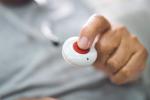
- Support portal
- Evaluation Kits and partner products
u-blox Support
- Product documentation
Documentation
- Investor relations
Investor relations
Whether in the form of smart watches, sport and fitness trackers, wearable health devices, or elderly and kid trackers, wearable technology has proven its potential to attract and satisfy a growing customer base.
Today, shrinking components, new functionality, and tighter integration are combining to make wearable devices more comfortable and more powerful, delivering increased value to their users.
Recent key technological developments benefiting wearable technology include:
Contact us and we'll be in touch as soon as possible
Wearable devices serve a growing number of use cases in consumer and professional applications. Smart watches help their users stay connected to the internet 24/7 and provide an always at hand interface, for example, for medical staff in hospitals. Sport and fitness trackers monitor user activity and output quantitative performance metrics, serving both everyday consumers and professional athletes. And smart glasses are paving the way for a wealth of augmented reality applications.
Wearable tracking devices are also seeing an uptick in adoption, with companies using them to track their staff to manage access control or lone workers operating in dangerous environments. Consumers have also embraced people trackers as a means of keeping an eye on vulnerable children and elderly individuals when they leave the home.
Medical use cases have also been among the first to benefit from wearable technology, be it to quantitatively monitor health parameters, transmit behavioral data to online cloud platforms, or administer drugs or other treatments. More recently, for example, wearable technology has been applied to monitor brain activity for the treatment of chronic pain.

Comfortable body-worn devices can track physical activities, sleep, and various physiological parameters (heart rate, heart-rate variability, blood pressure, oxygen saturation, etc.) to assess health and wellbeing and visualize them on smartphone apps or online platforms.
Connected medical-grade wearable devices with biosensors gather health data for early detection and diagnosis of pathologies, e.g., Parkinson’s disease, and deliver tailored therapeutic treatment based on real-time data, e.g., releasing insulin for those suffering from diabetes.
Wearable IoT devices such as smart bracelets, smart watches, or lanyards identify and authenticate individuals in corporate environments to allow, deny, or limit their access to sensitive facilities with restricted access.
Featuring an emergency button and motion sensors capable of detecting falls, prolonged inactivity or abnormal physiological parameters, GPS-enabled wearables protect lone workers operating in isolated environments by manually or automatically transmitting geo-tagged distress signals in the event of an accident.
GPS-enabled location trackers protect children, people suffering from disabilities, elderly individuals, and other vulnerable populations by monitoring their location, helping parents, relatives, and caregivers look after them.
Worn on the body 24/7, wearable devices need to respond to high user expectations in terms of comfort, ease of maintenance, and security.
u-blox has proven its strengths and capabilities in this challenging applications with smart watches, health and fitness wearables, people trackers, and wearable medical devices.




Contact us and we'll be in touch as soon as possible